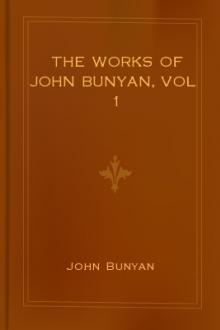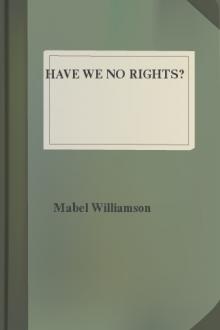The Works of John Bunyan, vol 1 - John Bunyan (best self help books to read TXT) 📗

- Author: John Bunyan
- Performer: -
Book online «The Works of John Bunyan, vol 1 - John Bunyan (best self help books to read TXT) 📗». Author John Bunyan
The carping criticisms of Mr. Dunlop, in his History of Fiction, and of an author in the Penny Encyclopedia, are scarcely worth notice. The complaint is, want of benevolence in the hero of the tale. How singular it is, and what a testimony to its excellence, that an intelligent writer upon fictions should have been so overpowered with this spiritual narrative, as to confound it with temporal things. Christian leaves his wife and children, instead of staying with them, to be involved in destruction—all this relates to inward spiritual feelings, and to these only. Visited by compunctions of heart, Christian strives to inspire his wife and children with the same, but in vain; he attends solitarily to his spiritual state, taunted by his family, while, as to temporal things, he becomes a better husband and father than ever he was—but this is not prominent, because it is entirely foreign to the author’s object, which is to display the inward emotions of the new birth, the spiritual journey alone, apart from all temporal affairs. Multitudes read it as if it was really a dream, the old sleeping portrait confirming the idea. In the story, Christian most mysteriously embodies all classes of men, from the prince to the peasant—the wealthiest noble, or merchant, to the humbles mechanic or labourer—and it illustrates the most solemn, certain truth, that, with respect to the salvation of the soul, the poorest creature in existence is upon perfect equality with the lordly prelate, or magnificent emperor, with this word ringing in their ears, ‘the POOR
have the gospel preached to them.’ The Grace Abounding, or Life of Bunyan, is a key to all the mysteries of The Pilgrim’s Progress, and Holy War.
Bunyan’s singular powers are those of description, not of invention.
He had lived in the city of destruction—he had heard the distant threatening of the awful storm that was shortly to swallow it up in unutterable ruin—he had felt the load of sin, and rejoiced when it was rolled away before a crucified Saviour—he knew every step of the way, and before he had himself passed the black river, he had watched prayerfully over those who were passing, and when the gate of the city was opened to let them enter, he had strained his eyes to see their glory.
The purifying influence of The Pilgrim’s Progress may be traced in the writings of many imaginative authors. How does it in several parts beautify the admirable tale of Uncle Tom, and his Cabin. In that inimitable scene, the death of the lovely Eva, the distressed negro, watching with intense anxiety the progress of death, says, ‘When that blessed child goes into the kingdom, they’ll open the door so wide, we’ll all get a look in at the glory.’ Whence came this strange idea—not limited to the poor negro, but felt by thousands who have watched over departing saints? It comes from the entrance of Christian and Hopeful into the celestial city—‘I looked in after them, and, behold, the city shone like the sun; the streets, also, were paved with gold, and in them they walked with crowns on their heads, palms in their hands, and golden harps to sing praises, which, when I had seen, I wished myself among them.’[299] How often has Bunyan’s wit sparkled in sermons, and even in speeches delivered in the senate. Recently, in a speech on the collation ministry, the following reference was introduced:—‘Mr.
Facing-both-ways, of honest John Bunyan, is not a creature mankind can regard with any complacency; nor will they likely suffer any one to act with one party, and reserve his principles for another.’
It has also been strangely quoted in novel writing—thus in Bell’s Villette—visiting a God-mother in a pleasant retreat, is said ‘to resemble the sojourn of Christian and Hopeful, beside the pleasant stream, with green trees on each bank, and meadows beautified with lilies all the year round.’ It is marvelous that a picture of nature should have been so beautifully and strikingly described by an unlettered artisan, as to be used in embellishing an elegant novel, written nearly two centuries after his decease.[300]
The Pilgrim was followed by a searching treatise on The Fear of God.
The value of this book led to its republication by the Tract Society, and 4000 copies have been circulated. It is a neat and acceptable volume, but why altered? and a psalm omitted.[301] Bunyan says, ‘Your great ranting, swaggering, roysters’; this is modernized into ‘Your ranting boasters.’[302] Then followed, the Come and Welcome to Jesus Christ. This was frequently reprinted, and hundreds of thousands have been circulated to benefit the world. His popularity increased with his years; efforts were made, but in vain, to steal him from his beloved charge at Bedford. ‘He hath refused a more plentiful income to keep his station,’ is the language of his surviving friend, Charles Doe. It is not surprising that he was thus tempted to leave his poor country church, for we are told by the same biographer, that ‘When Mr. Bunyan preached in London, if there were but one day’s notice given, there would be more people come together to hear him preach, than the meeting-house could hold.
I have seen to hear him preach, by my computation, about 1200 at a morning lecture, by seven o’clock, on a working day, in the dark winter time. I also computed about 3000 that came to hear him one Lord’s-day, at London, at a town’s end meeting-house, so that half were fain to go back again for want of room, and then himself was fain at a back door to be pulled almost over people to get up stairs to his pulpit.’ This took place in a large meeting-house, erected in Zoar Street, either on the site or near the Globe Theatre, Southwark.[303] On this spot, the prince of dramatists amused and corrupted crowded houses; while in the immediate vicinity were the stews and bear garden, frequented by libertines of the lowest caste. One Sunday, in 1582, many were killed or miserably wounded while attending the brutal sport of bear-baiting. Here, in the heart of Satan’s empire, the prince of allegorists attracted multitudes, to be enlightened by his natural eloquence, and to be benefited by the fruits of his prolific and vivid imagination, at all times curbed and directed by the holy oracles. It was a spacious building, covering about 2000 feet of ground (50 by 40), with three galleries, quite capable of holding the number computed by Mr. Doe. We have, from correct drawings, furnished our subscribers with the plan and elevation of this ancient meeting-house. Having preached with peculiar warmth and enlargement, one of his friends took him by the hand, and could not help observing what a sweet sermon he had delivered; ‘Ay,’ said he, ‘you need not remind me of that, for the devil told me of it before I was out of the pulpit!’[304] Amongst his hearers were to be found the learned and the illiterate. It was well known that Dr. John Owen, when he had the opportunity, embraced it with pleasure, and sat at the feet of the unlearned, but eloquent tinker. Charles II, hearing of it, asked the learned D.D., ‘How a man of his great erudition could sit to hear a tinker preach?’ to which the doctor replied, ‘May it please your Majesty, if I could possess the tinker’s abilities, I would gladly give in exchange all my learning.’
He now pictured the downward road of the sinner to the realms of death and darkness in the Life of Badman. This was published in 1680, and is written in a language which fraudulent tradesmen at that period could not misunderstand; using terms now obsolete or vulgar. It is full of anecdotes, which reveal the state of the times, as superlatively immoral, and profane. He incidentally notices that a labourer received eightpence or tenpence per day.[305] At that time, bread and all the necessaries of life, excepting meat, were dearer than they are at present. In fact, our days are much happier for the poor than any preceding ones in British history. Bunyan’s notions of conscientious dealing, will make all traders who read them—blush.[306]
November 12, 1681, Bunyan’s friend and fellow-labourer Samuel Fenn, was removed from this world, and in the following year persecution raged severely. The church was, for a season, driven from the meeting-house, and obliged to assemble in the fields. The Word of the Lord was precious in those days.
In 1682, while surrounded by persecution, he prepared and published his most profound and beautiful allegory, The Holy War, made by Shaddai upon Diabolus, for the Regaining of the Metropolis of the World; or, The Losing and Taking again the Town of Mansoul.[307]
The frontispiece is the most accurate likeness of Bunyan that is extant; it is engraved by White, from a drawing, also by him, now preserved in the print department of the British Museum. From this drawing, carefully compared with the print, we have furnished the expressive likeness which forms the frontispiece to this volume.
It has also a correct whole-length portrait, with emblematical devices. This exceedingly beautiful and most finished allegory has never been so popular as The Pilgrim’s Progress, for reasons which are shown in the introduction to The Holy War.[308] The whole narrative of this wondrous war appears to flow as naturally as did that of the pilgrimage from the highly imaginative mind of the author. Man, in his innocence, attracts the notice and hatred of Apollyon. Nothing could be accomplished by force—all by subtlety and deceit. He holds a council of war—selects his officers—approaches—parleys, and gains admittance—then fortifies the town against its king—Immanuel determines to recover it—vast armies, under appropriate leaders, surround the town, and attack every gate. The ear is garrisoned by Captain Prejudice and his deaf men. But he who rides forth conquering and to conquer is victorious.
All the pomp, and parade, and horrors of a siege are as accurately told, as if by one who had been at the sacking of many towns. The author had learnt much in a little time, at the siege of Leicester.
All the sad elements of war appear, and make us shudder—masses of armed men with their slings and battering-rams—clarions and shouts—wounded and slain, all appear as in a panorama. The mind becomes entranced, and when sober reflection regains her command, we naturally inquire, Can all this have taken place in my heart?
Then the armies of Diabolus, with his thousands of Election Doubters, and as many Vocation Doubters, and his troops of Blood-men—thousands slain, and yet thousands start into existence. And all this in one man! How numberless are our thoughts—how crafty the approaches of the enemy—how hopeless and helpless is the sinner, unless Immanuel undertakes his recovery. The Holy War is a most surprising narrative of the fall and of the recovery of man’s soul, as accurate as it is most deeply interesting. It is one of the most perfect of allegories.[309] There is as vast a superiority in Bunyan’s Holy War over that by Chrysostom, as there is in the sun over a rush-light.
In 1684, he completed his Pilgrim’s Progress, with the Journey of a Female Christian, her Children, and the Lovely Mercy; and now, as his invaluable and active life drew towards its close, his labours were redoubled. In his younger days, there appeared to have





Comments (0)